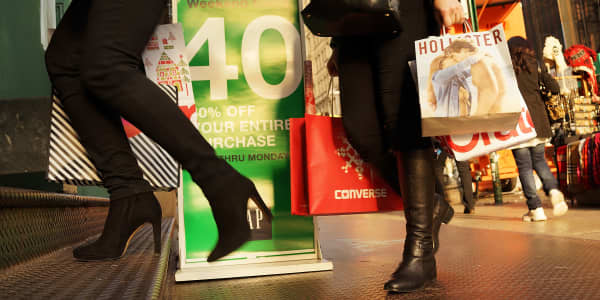As December approaches, so do the Christmas adverts. Eager to grab a slice of the £40 million ($65.4 million) that is expected to be spent this festive season, according to Deloitte, the U.K.'s retailers battle to outdo themselves to produce the most glamorous, sentimental and heart-warming Christmas campaign.
So far this year, the U.K has seen family Christmases through the years from supermarket Tesco, soldiers reunited with their families at supermarket J. Sainsbury and Alice in Wonderland from retailer Marks and Spencer.
And usually, the bigger the budget, the bigger the impact. But maybe not this year.
High-end department store Harvey Nichols – which has eight stores across the U.K. and Ireland – lacks the budget of its larger rivals, but its 2013 festive advertisement has caused quite a stir.
(Read more: Black Friday shoppers beware – the 12 scams of Christmas)
The "Sorry, I Spent It On Myself" campaign, launched on the retailer's website and YouTube page this week, encourages shoppers to spend less on their loved ones this Christmas – and more on themselves.
To accompany the adverts, the retailer has launched a range of what it called "Ultra Low Net Worth" (ULNW) gifts, including a pack of "authentic Lincolnshire gravel" – which costs £1.61 ($2.63) – and a "genuine wire sponge" (96 pence).
The advert shows gift-givers – themselves wearing new, designer clothes and accessories - giving their loved ones the basic presents on Christmas day.
The Harvey Nichols campaign's budget feel stands in stark contrast to its – albeit much larger – competitors like John Lewis, which spent £7 million on its much-anticipated Christmas advert, in which an animated hare wakes up his bear friend from hibernation so he does not miss Christmas.
Tapping Twitter
But despite budget limitations (Harvey Nichols would not disclose the cost of its campaign), the advert was well received on Twitter, with #SpentItOnMyself trending on the microblogging website following its launch.
Not everyone was so impressed, however, with some Twitter users saying the campaign missed the spirit of the festive season.
The experts' verdict?
Geoff Gower, executive creative director of creative agency AIS London, said that although the idea behind Harvey Nichols' campaign was good, it had failed to execute it successfully.
"It was clearly made on a budget, but they should have done more with less, and not settled for this ad - which certainly doesn't feel premium," he told CNBC.
Gower added that the campaign also appeared to miss the retailers' high-end target market, if the Twitter attention was anything to go by.
"It's appealing to a younger, less affluent audience and doesn't feel commensurate with the company's market. If you shop at Harvey Nichols you generally afford to spoil yourself AND your loved ones. You don't have to buy them some elastic bands," he said.
(Read more: Online sales 'to hit £5 billion' this Christmas)
The company's Marketing Director, Julia Bowe, said the campaign was "a bit fun."
"We hope that our new 'Sorry, I Spent It On Myself' Gift Collection will provide our fashion-loving customers with a tongue-in-cheek stocking-filler, and the perfect excuse to treat themselves to that must-have fashion item that they've been lusting after all year! Christmas is, after all, about giving and receiving, even if it is from yourself," she said in a statement.
Lynsey Sweales, CEO of social media and online marketing agency SocialB, argued that the campaign was a risk – that had paid off.
"People perceive Harvey Nichols as expensive: perhaps they're trying to appeal to different market with this tongue-in-cheek campaign," she told CNBC.
"They've used their budget cleverly to tap into social media – and if you can judge how successful an ad is by how much buzz it's generating on these sites, Harvey Nichols is putting up a good fight."
Gower was keen to stress, however, that although the campaign did not rely on traditional advertising platforms, it was far from innovative: "They have just made a television advert and put it somewhere else."
The fact that the Harvey Nichols campaign will not be broadcast on television sets it apart from the majority of the big-name retailers' festive offerings. The premier of John Lewis' much-talked-about advert, for instance, was considered such an event that it was live-blogged by some U.K. newspapers.
The bear and hare campaign by John Lewis, which has 40 stores across the U.K., has been "phenomenally successful," according to Gower.
"It's unquestionably appealed to a really difficult audience, which basically encompasses the whole of the U.K.," he said.
(Read more: Thanksgiving: Luxury bird competes with budget turkey)
In a release accompanying the campaign launch, John Lewis' Marketing Director Craig Inglis said the advert was designed to "evoke nostalgia and build anticipation" in the run-up to the festive season.
"We wanted our advert to reflect the importance of finding the right gift for friends and loved ones, a theme which we have built on for a number of years," he said.
To date, it has been viewed over 9 million times since its launch on November 8 on YouTube.
By contrast, Harvey Nichols' advert has been viewed 100,000 time since its launch on November 25 – which, given the lack of a television profile, is "killer marketing," according to SocialB's Sweales.
—By CNBC's Katrina Bishop. Follow her on Twitter @KatrinaBishop and Google





